KIA Optima 2006 2.G Owner's Manual
Manufacturer: KIA, Model Year: 2006, Model line: Optima, Model: KIA Optima 2006 2.GPages: 225, PDF Size: 3.77 MB
Page 131 of 225
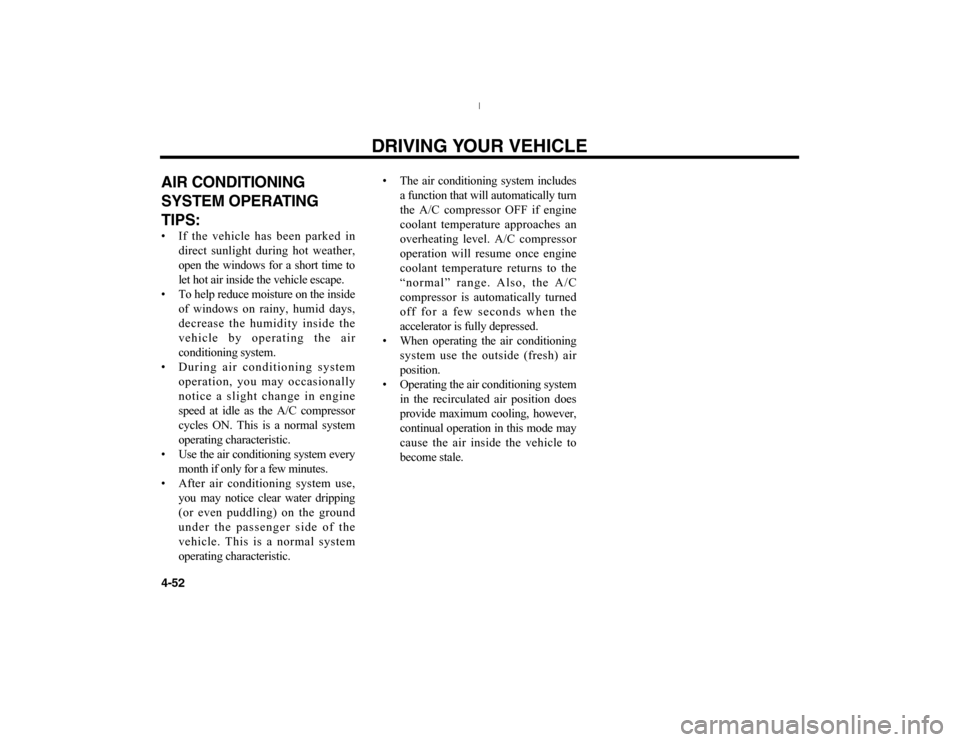
DRIVING YOUR VEHICLE
4-52AIR CONDITIONING
SYSTEM OPERATING
TIPS:• If the vehicle has been parked in
direct sunlight during hot weather,
open the windows for a short time to
let hot air inside the vehicle escape.
• To help reduce moisture on the inside
of windows on rainy, humid days,
decrease the humidity inside the
vehicle by operating the air
conditioning system.
• During air conditioning system
operation, you may occasionally
notice a slight change in engine
speed at idle as the A/C compressor
cycles ON. This is a normal system
operating characteristic.
• Use the air conditioning system every
month if only for a few minutes.
• After air conditioning system use,
you may notice clear water dripping
(or even puddling) on the ground
under the passenger side of the
vehicle. This is a normal system
operating characteristic.• The air conditioning system includes
a function that will automatically turn
the A/C compressor OFF if engine
coolant temperature approaches an
overheating level. A/C compressor
operation will resume once engine
coolant temperature returns to the
“normal” range. Also, the A/C
compressor is automatically turned
off for a few seconds when the
accelerator is fully depressed.
• When operating the air conditioning
system use the outside (fresh) air
position.
• Operating the air conditioning system
in the recirculated air position does
provide maximum cooling, however,
continual operation in this mode may
cause the air inside the vehicle to
become stale.
MS-CNA-Eng 4(40~).QXD 7/25/2005 5:15 PM Page 52
Page 132 of 225

4-53
REAR HEATER DUCT
(IF EQUIPPED)Whenever the ventilation controls are in
the face-floor or floor position, air is
directed to the rear seat passenger floor
area.AIR QUALITY CONTROL
SYSTEM (IF EQUIPPED)The air inflow from the outside of the
vehicle can be automatically controlled.
Press the button to activate the “Air
Quality Control System”. To deactivate
the system, press the button or air
intake control button or set modes
selection knob to position.
When using AQS mode, AQS(Air
Quality Control System) automatically
senses outdoor air pollutants and
minimizes them from entering the
vehicle, however, unpleasant or foul
odors that might be present may still be
noticeable within the vehicle.
CAUTION
Prolonged driving with “Air
Quality Control System” ON
will cause frosting inside the
vehicle.
To defrost the vehicle, set the
mode selection knob to Defrost
( ) position or the air intake
button to the outside position.
The air quality control sensor is
located at the side of the radia-
tor. Be careful to avoid damag-
ing the sensor.
MS-CNA-Eng 4(40~).QXD 7/25/2005 5:15 PM Page 53
Page 133 of 225
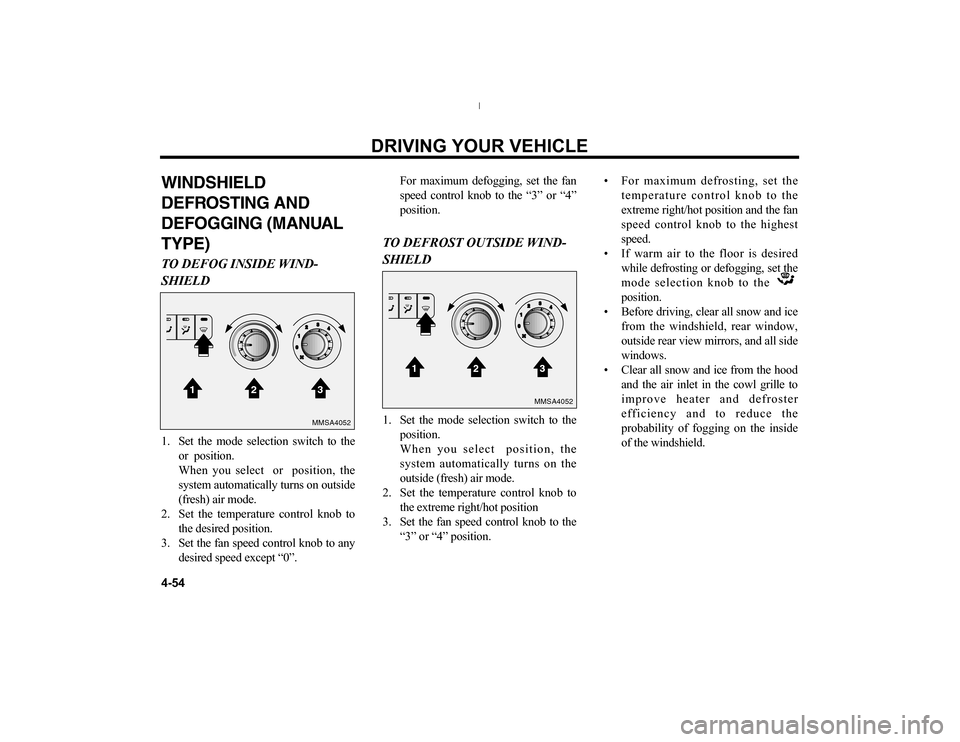
WINDSHIELD
DEFROSTING AND
DEFOGGING (MANUAL
TYPE)TO DEFOG INSIDE WIND-
SHIELD1. Set the mode selection switch to the
or position.
When you select or position, the
system automatically turns on outside
(fresh) air mode.
2. Set the temperature control knob to
the desired position.
3. Set the fan speed control knob to any
desired speed except “0”.For maximum defogging, set the fan
speed control knob to the “3” or “4”
position.
TO DEFROST OUTSIDE WIND-
SHIELD1. Set the mode selection switch to the
position.
When you select position, the
system automatically turns on the
outside (fresh) air mode.
2. Set the temperature control knob to
the extreme right/hot position
3. Set the fan speed control knob to the
“3” or “4” position.• For maximum defrosting, set the
temperature control knob to the
extreme right/hot position and the fan
speed control knob to the highest
speed.
• If warm air to the floor is desired
while defrosting or defogging, set the
mode selection knob to the
position.
• Before driving, clear all snow and ice
from the windshield, rear window,
outside rear view mirrors, and all side
windows.
• Clear all snow and ice from the hood
and the air inlet in the cowl grille to
improve heater and defroster
efficiency and to reduce the
probability of fogging on the inside
of the windshield.DRIVING YOUR VEHICLE
4-54
123
4
0
2
3
1
MMSA4052
123
4
0
2
3
1
MMSA4052
MS-CNA-Eng 4(40~).QXD 7/25/2005 5:15 PM Page 54
Page 134 of 225
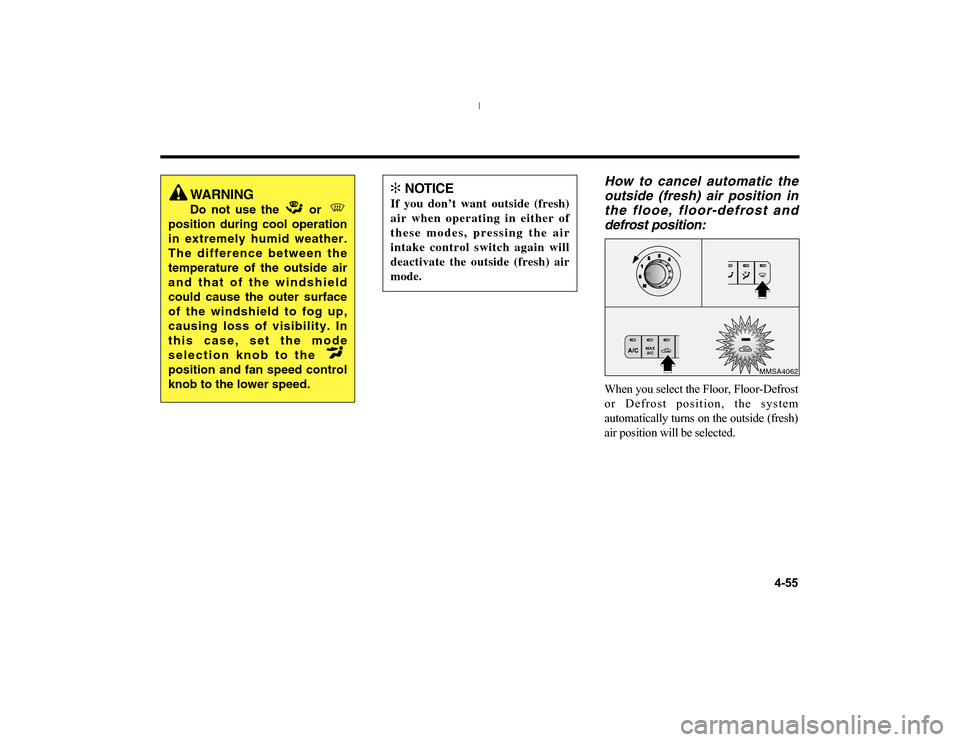
How to cancel automatic the
outside (fresh) air position in
the flooe, floor-defrost and
defrost position:When you select the Floor, Floor-Defrost
or Defrost position, the system
automatically turns on the outside (fresh)
air position will be selected.
4-55
123
4
0MAX
A/C
MMSA4062
WARNINGDo not use the or
position during cool operation
in extremely humid weather.
The difference between the
temperature of the outside air
and that of the windshield
could cause the outer surface
of the windshield to fog up,
causing loss of visibility. In
this case, set the mode
selection knob to the
position and fan speed control
knob to the lower speed.
✻
NOTICE
If you don’t want outside (fresh)
air when operating in either of
these modes, pressing the air
intake control switch again will
deactivate the outside (fresh) air
mode.
MS-CNA-Eng 4(40~).QXD 7/25/2005 5:15 PM Page 55
Page 135 of 225

If you don’t want the outside (fresh) air
position when operating in either of these
modes, you can turn off the system
operation by performing the following:
1. Make sure the engine is running or
the ignition switch is in the ON
position.
2. Turn the fan speed control knob to
the “0” position.
3. Turn the mode selection knob to the
defrost ( ) position.
4. Push the air intake control button
( ) at least 5 times within 3
seconds.
5. Then the indicator light on the air
intake control button ( ) will blink
3 times with 0.5 second intervals
between blinks.
If you want to return to the outside
(fresh) air position, repeat the procedure
above.
WINDSHIELD DEFROST-
ING AND DEFOGGING
(AUTOMATIC TYPE)TO DEFOG INSIDE WINDSHIELD1. Select any fan speed except OFF
( ) position.
2. Select desired temperature.
3. Press the defrost button ( ).
4. The air conditioning will be turned
on according to the detected ambient
temperature and outside (fresh) air
position will be selected.
If you don’t want the air conditioning or
outside (fresh) air position press the
corresponding button to cancel the
operation.
TO DEFROST OUTSIDE
WINDSHIELD 1. Set temperature to the extreme hot
(25°C~32°C) position.
2. Set the fan speed to the or
position.
3. Press the defrost button ( ).
4. The air conditioning will be turned
on according to the detected ambient
temperature and outside (fresh) air
position will be selected.
If you don’t want the air conditioning or
outside (fresh) air position press the
corresponding button to cancel the
operation.
• Before driving, clear all snow and ice
from the windshield, rear window,
outside rear view mirrors, and all side
windows.
• Clear all snow and ice from the hood
and the air inlet in the cowl grille to
improve heater and defroster
efficiency and to reduce the
probability of fogging on the inside
of the windshield.
DRIVING YOUR VEHICLE
4-56
A/C
1
2
34
MMSA4055
MS-CNA-Eng 4(40~).QXD 7/25/2005 5:15 PM Page 56
Page 136 of 225
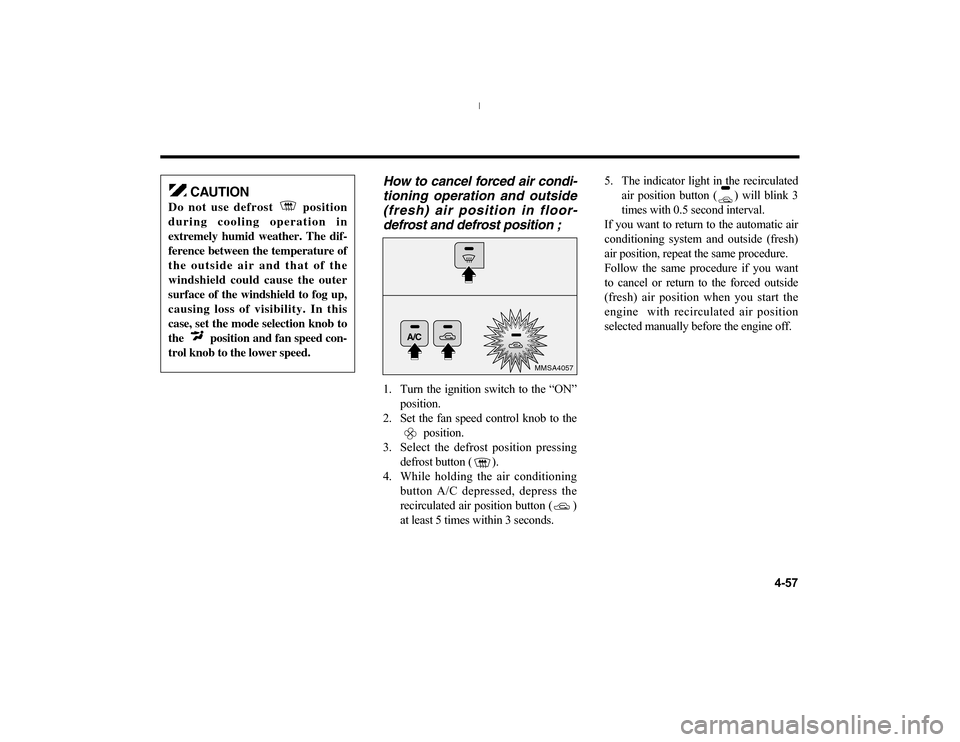
How to cancel forced air condi-
tioning operation and outside
(fresh) air position in floor-
defrost and defrost position ;1. Turn the ignition switch to the “ON”
position.
2. Set the fan speed control knob to the
position.
3. Select the defrost position pressing
defrost button ( ).
4. While holding the air conditioning
button A/C depressed, depress the
recirculated air position button ( )
at least 5 times within 3 seconds.5. The indicator light in the recirculated
air position button ( ) will blink 3
times with 0.5 second interval.
If you want to return to the automatic air
conditioning system and outside (fresh)
air position, repeat the same procedure.
Follow the same procedure if you want
to cancel or return to the forced outside
(fresh) air position when you start the
engine with recirculated air position
selected manually before the engine off.
4-57
A/C
MMSA4057
CAUTION
Do not use defrost position
during cooling operation in
extremely humid weather. The dif-
ference between the temperature of
the outside air and that of the
windshield could cause the outer
surface of the windshield to fog up,
causing loss of visibility. In this
case, set the mode selection knob to
the position and fan speed con-
trol knob to the lower speed.
MS-CNA-Eng 4(40~).QXD 7/25/2005 5:15 PM Page 57
Page 137 of 225
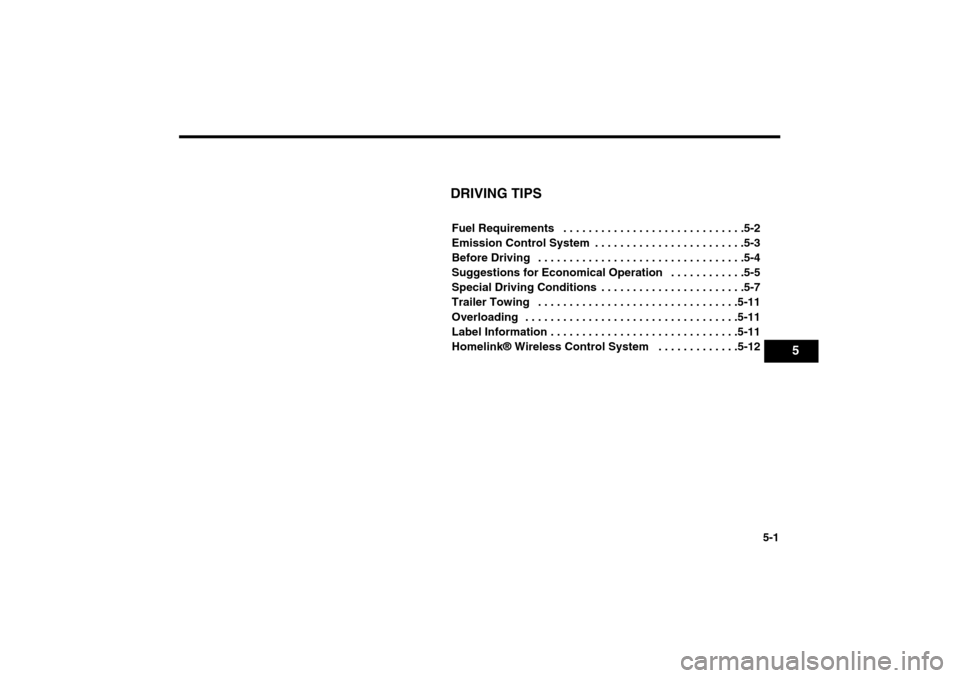
5-1
DRIVING TIPSFuel Requirements . . . . . . . . . . . . . . . . . . . . . . . . . . . . .5-2
Emission Control System . . . . . . . . . . . . . . . . . . . . . . . .5-3
Before Driving . . . . . . . . . . . . . . . . . . . . . . . . . . . . . . . . .5-4
Suggestions for Economical Operation . . . . . . . . . . . .5-5
Special Driving Conditions . . . . . . . . . . . . . . . . . . . . . . .5-7
Trailer Towing . . . . . . . . . . . . . . . . . . . . . . . . . . . . . . . .5-11
Overloading . . . . . . . . . . . . . . . . . . . . . . . . . . . . . . . . . .5-11
Label Information . . . . . . . . . . . . . . . . . . . . . . . . . . . . . .5-11
Homelink® Wireless Control System . . . . . . . . . . . . .5-12
5
MS-CNA-Eng 5 New.qxd 7/25/2005 5:21 PM Page 1
Page 138 of 225

DRIVING TIPS
5-2FUEL REQUIREMENTSYour new Kia Vehicle must use only
UNLEADED FUEL having an octane
rating of 87 or higher. Your new Kia is
designed to obtain maximum performance
with unleaded fuel. Unleaded fuel will
minimize exhaust emissions and spark
plug fouling.
GASOLINE CONTAINING
ALCOHOL AND METHANOLEthanol (also known as grain alcohol) is
a mixture of ethanol and gasoline
marketed as gasohol. Do not use gasohol
containing more than 10% ethanol.
Methanol (also known as wood alcohol)
is a mixture of gasoline and methanol
marketed as gasohol. Do not use gasoline
or gasohol containing methanol.
Either of these fuels may cause
driveability problems and damage to the
fuel system.
Discontinue using gasohol of any kind if
driveability problems occur.
Vehicle damage or driveability problems
may not be covered by the manufacturer’s
warranty if they result from the use of:
Gasohol containing more than 10%
ethanol,
Gasoline or gasohol containing
methanol, or
Leaded fuel or leaded gasohol
✻
NOTICE
NEVER USE LEADED FUEL. The
use of leaded fuel is detrimental to
the catalytic converter. Never add
any fuel system cleaning agents to
the fuel tank other than what Kia
has specified or the equivalent.
(Consult an Authorized Kia Dealer
for details.)
Leaded fuel will damage the engine
control system’s oxygen sensor and
affect the emission control system.
✻
NOTICE
Never use gashol which contains
methanol. Discontinue use of any
gashohol product which impairs
driveability.
MS-CNA-Eng 5 New.qxd 7/25/2005 5:21 PM Page 2
Page 139 of 225

5-3
EMISSION CONTROL
SYSTEM The vehicle emission control system is
covered by a written limited warranty.
Please see the warranty & consumer
information manual in your vehicle.VEHICLE MODIFICATIONSThis vehicle should not be modified.
Modification of your Kia could affect its
performance, safety or durability and
may even violate governmental safety
and emissions regulations.
In addition, damage or performance
problems resulting from any modification
may not be covered under warranty.
ENGINE EXHAUST GAS
PRECAUTIONS
(CARBON MONOXIDE)Engine exhaust gases contain carbon
monoxide. Though colorless and
odorless, it is dangerous and could be
lethal, if inhaled.
Carbon monoxide can be present
with other exhaust fumes.
Therefore, if you smell exhaust
fumes of any kind inside your
vehicle, have it inspected and
repaired immediately by an
Authorized Kia Dealer. If at all
possible, do not drive with exhaust
fumes present. If you must, do so
only with all windows fully open.
Have your vehicle checked and
repaired immediately.
Do not operate the engine in confined
or closed areas (such as garages) any
more than what is necessary to move
the vehicle in or out of the area. When the vehicle is stopped in an
open area for more than a short time
with the engine running, adjust the
ventilation system to draw outside air
into the vehicle.
Turn the engine off if you smell any
exhaust fumes.
Never sit in a parked or stopped
vehicle for an extended time with the
engine running.
When the engine stalls or fails to
start, excessive attempts to re-start
the engine may cause damage to the
emission control system.
OPERATING PRECAUTIONS
FOR CATALYTIC CONVERTERSYour vehicle is equipped with a catalytic
converter emission control device.
Therefore, the following precautions
must be observed:
Use only UNLEADED FUEL.
Do not park the vehicle over or near
flammable objects, such as dry grass,
paper, leaves, etc. Under certain
conditions, they could be ignited by a
hot exhaust system.
MS-CNA-Eng 5 New.qxd 7/25/2005 5:21 PM Page 3
Page 140 of 225
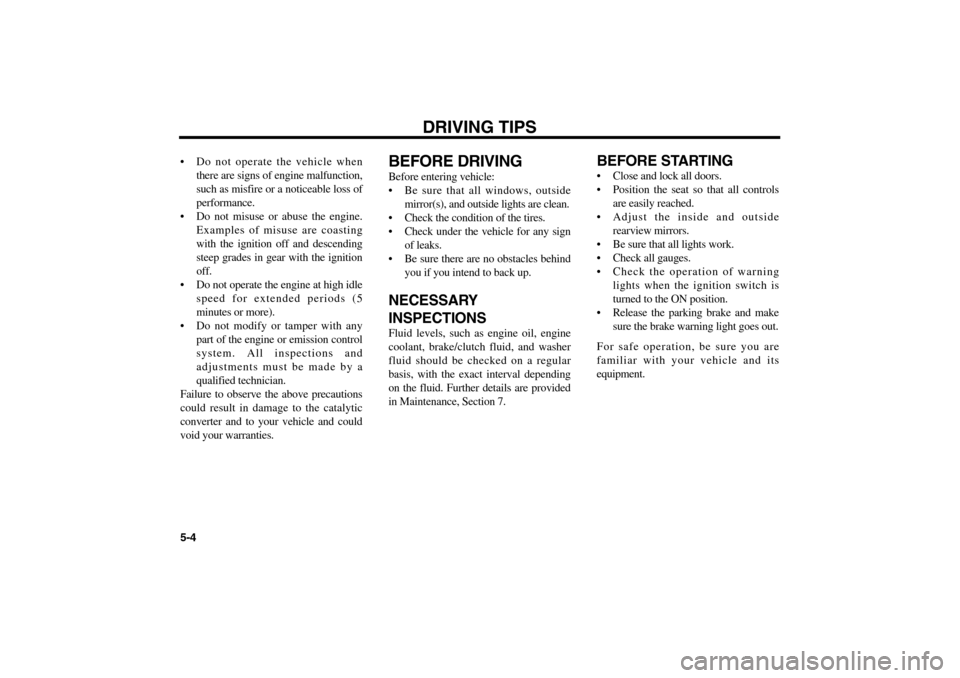
DRIVING TIPS
5-4 Do not operate the vehicle when
there are signs of engine malfunction,
such as misfire or a noticeable loss of
performance.
Do not misuse or abuse the engine.
Examples of misuse are coasting
with the ignition off and descending
steep grades in gear with the ignition
off.
Do not operate the engine at high idle
speed for extended periods (5
minutes or more).
Do not modify or tamper with any
part of the engine or emission control
system. All inspections and
adjustments must be made by a
qualified technician.
Failure to observe the above precautions
could result in damage to the catalytic
converter and to your vehicle and could
void your warranties.
BEFORE DRIVINGBefore entering vehicle:
Be sure that all windows, outside
mirror(s), and outside lights are clean.
Check the condition of the tires.
Check under the vehicle for any sign
of leaks.
Be sure there are no obstacles behind
you if you intend to back up.NECESSARY
INSPECTIONSFluid levels, such as engine oil, engine
coolant, brake/clutch fluid, and washer
fluid should be checked on a regular
basis, with the exact interval depending
on the fluid. Further details are provided
in Maintenance, Section 7.
BEFORE STARTING Close and lock all doors.
Position the seat so that all controls
are easily reached.
Adjust the inside and outside
rearview mirrors.
Be sure that all lights work.
Check all gauges.
Check the operation of warning
lights when the ignition switch is
turned to the ON position.
Release the parking brake and make
sure the brake warning light goes out.
For safe operation, be sure you are
familiar with your vehicle and its
equipment.
MS-CNA-Eng 5 New.qxd 7/25/2005 5:21 PM Page 4